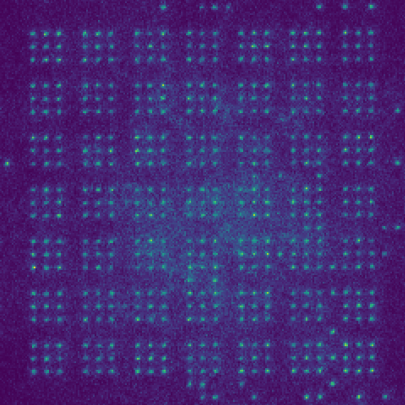1,000 atomic qubits and rising

Experimental setup for the operation of a quantum processor architecture with over 1,000 single-atom quantum bits at TU Darmstadt.
Picture: Klaus Mai
A new record for atom-based quantum computers.
Making quantum systems more scalable is one of the key requirements for the further development of quantum computers because the advantages they offer become increasingly evident as the systems are scaled up. Researchers at TU Darmstadt have recently taken a decisive step towards achieving this goal. The results of their research have now been published in a prestigious publication.
Quantum processors based on two-dimensional arrays of optical tweezers, which are created using focussed laser beams, are one of the most promising technologies for developing quantum computing and simulation that will enable highly beneficial applications in the future. A diverse range of applications from drug development through to optimising traffic flows will benefit from this technology.
These processors have been able to hold several hundred single-atom quantum systems up to now, whereby each atom represents one quantum bit or qubit as the basic unit of quantum information. In order to make further advances, it is necessary to increase the number of qubits in the processors. This has now been achieved by a team headed by Professor Gerhard Birkl from the “Atoms – Photons – Quanta” research group in the Department of Physics at TU Darmstadt.
In a research article, which was first published at the beginning of October 2023 on the arXiv preprint server and has now also been published following scientific peer review in the prestigious journal OPTICA, the team reports on the world’s first successful experiment to realise a quantum-processing architecture that contains more than 1,000 atomic qubits in one single plane.
“We are extremely pleased that we were the first to break the mark of 1,000 individually controllable atomic qubits because so many other outstanding competitors are hot on our heels”, says Birkl about their results.
The researchers were able to demonstrate in their experiments that their approach of combining the latest quantum-optical methods with advanced micro-optical technology has enabled them to significantly increase the current limits on the accessible number of qubits.
This was achieved by introducing the novel method of “quantum bit supercharging”. It allowed them to overcome the restrictions imposed on the number of usable qubits by the limited performance of the lasers. 1305 single-atom qubits were loaded in a quantum array with 3,000 trap sites and reassembled into defect-free target structures with up to 441 qubits. By using several laser sources in parallel, this concept has broken through the technological boundaries that had been perceived as being almost insurmountable up to now.
For many different applications, 1,000 qubits is seen as the threshold value from which the boost to efficiency promised by quantum computers can now be demonstrated for the first time. Researchers around the world have thus been working intensively to be the first to break this threshold. The recently published research work demonstrates that for atomic qubits this breakthrough was achieved for the first time worldwide by the research group headed by Professor Birkl. The scientific publication also describes how further increases in the number of laser sources will enable qubit numbers of 10,000 and more in just a few years.
Wissenschaftliche Ansprechpartner:
Prof. Dr. Gerhard Birkl
Tel.: +49 6151 16-20410
E-Mail: gerhard.birkl.2024@e-mail.de
Originalpublikation:
Lars Pause, Lukas Sturm, Marcel Mittenbühler, Stephan Amann, Tilman Preuschoff, Dominik Schäffner, Malte Schlosser and Gerhard Birkl: “Supercharged two-dimensional tweezer array with more than 1000 atomic qubits”, in Optica Vol. 11, Issue 2, pp. 222-226 (2024)
DOI: https://doi.org/10.1364/OPTICA.513551
https://www.tu-darmstadt.de/universitaet/aktuelles_meldungen/einzelansicht_439104.en.jsp
Media Contact
All latest news from the category: Information Technology
Here you can find a summary of innovations in the fields of information and data processing and up-to-date developments on IT equipment and hardware.
This area covers topics such as IT services, IT architectures, IT management and telecommunications.
Newest articles

First-of-its-kind study uses remote sensing to monitor plastic debris in rivers and lakes
Remote sensing creates a cost-effective solution to monitoring plastic pollution. A first-of-its-kind study from researchers at the University of Minnesota Twin Cities shows how remote sensing can help monitor and…

Laser-based artificial neuron mimics nerve cell functions at lightning speed
With a processing speed a billion times faster than nature, chip-based laser neuron could help advance AI tasks such as pattern recognition and sequence prediction. Researchers have developed a laser-based…

Optimising the processing of plastic waste
Just one look in the yellow bin reveals a colourful jumble of different types of plastic. However, the purer and more uniform plastic waste is, the easier it is to…




